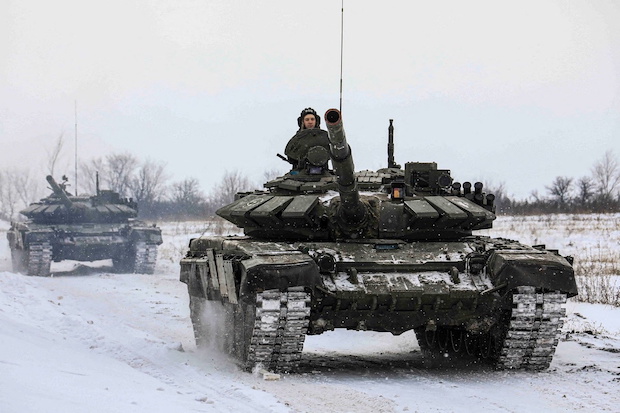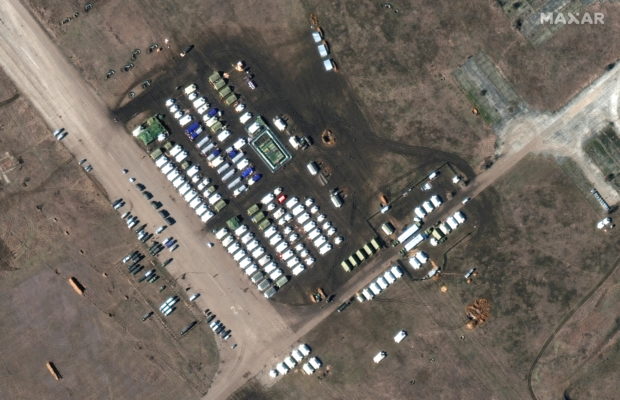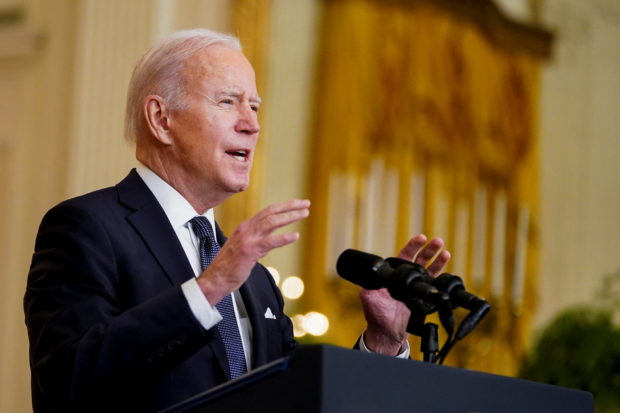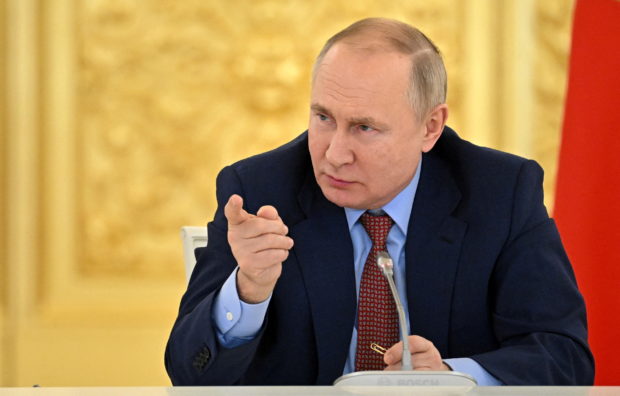Russia-Ukraine Crisis: What you need to know

Russian servicemen drive tanks during military exercises in the Leningrad Region, Russia, in this handout picture released Feb. 14, 2022. (Russian Defense Ministry/Handout via REUTERS/File Photo)
On Monday, Russian President Vladimir Putin recognized the independence of the two Ukrainian secessionist republics and ordered his troops to deploy there.
The following is what you need to know about the conflict in Ukraine that has left more than 14,000 dead since 2014.
How it began
In 2014, after the pro-European Union revolution in Ukraine which forces out the Kremlin-backed leader Viktor Yanukovych, Russia retaliates by annexing the Crimea peninsula.
The annexation is not recognized by the international community.
A separatist uprising then emerges in Donetsk and Lugansk in eastern Ukraine on the border with Russia. They declare independence, unleashing an intense armed conflict with Kyiv.
Article continues after this advertisement
A satellite image shows a close-up of troops and equipment at Oktyabrskoye air base, Crimea February 10, 2022. 2022 Maxar Technologies/Handout via REUTERS
Kyiv and the West say Russia instigated the eastern uprising and poured arms and troops across the border to bolster them.
Article continues after this advertisementMoscow denies the accusations, while acknowledging the presence of Russian “volunteers”.
The conflict has largely abated since 2015 and the signature of the Minsk peace agreements.
But since late 2021, Russia has stepped up military maneuvers, by air, land and sea, around Ukrainian territory, stationing more than 150,000 soldiers on its border, according to Western estimates.
How the world reacted
Western powers reacted swiftly to Putin’s decision to recognize the independence of the two self-proclaimed republics in eastern Ukraine, condemning Moscow and calling for sanctions.
French President Emmanuel Macron, German Chancellor Olaf Scholz and US President Joe Biden agree that “this step will not go unanswered”.
United Nations chief Antonio Guterres says Russia’s decision amounts to “a violation of the territorial integrity and sovereignty of Ukraine and inconsistent with the principles of the Charter of the United Nations”.

U.S. President Joe Biden speaks about the situation in Russia and Ukraine from the White House in Washington, U.S., February 15, 2022. REUTERS FILE PHOTO
European Union foreign ministers are to adopt sanctions against Russia over its recognition of the separatist regions and a further deployment of troops on its neighbors territory, the bloc’s foreign policy chief says.
German Chancellor Olaf Scholz says he is suspending the Nord Stream 2 pipeline project with Russia in response to Moscow’s recognition of the two breakaway regions.
UK Prime Minister Boris Johnson denounces Putin’s decision as “a flagrant violation of the sovereignty and integrity of the Ukraine”.
Serbian President Aleksandar Vucic says there are fears that the Ukraine crisis “could spread in other parts of Europe and the world, especially on the Western Balkans”.
Japan’s Prime Minister Fumio Kishida says Russia’s actions “cannot be tolerated”.
Beijing — one of Russia’s closest allies — does not take sides, instead calling for all parties to “avoid any action that may fuel tensions”.
Pope Francis says “increasingly alarming scenarios” were emerging in Ukraine that were threatening “the peace of all” amid fears of a Russian invasion.
Where will Putin stop?
Western countries have been warning for weeks that Moscow may be preparing for a possible all-out massed invasion to conquer its neighbor. Russia denies this, and Putin’s moves so far have stopped well short of such a scenario.
But a televised address by Putin on Monday night – in which he characterized the Ukrainian state and its leaders as illegitimate – added to fears that he may aim to subjugate Ukraine by force.

Russian President Vladimir Putin meets with members of the Delovaya Rossiya (Business Russia) All-Russian Public Organization at the Kremlin, in Moscow, Russia February 3, 2022. Sputnik/Aleksey Nikolskyi/Kremlin via REUTERS
Following are three possible scenarios:
1. Secure existing separatist enclaves — While many commentators believe that sending troops into the separatist enclaves could be a first step towards a wider invasion, others note that it could also be a place to stop – or at least pause in terms of action on the ground – while trying to apply pressure to Ukraine in other ways.
2. Seek to expand separatist territory — The separatists in eastern Ukraine control less than half of the two provinces they claim, and Ukrainian forces have opposed them across a heavily fortified frontline frozen by a much-violated ceasefire since 2015. Without launching a massed invasion of Ukraine as a whole, Russia could try to expand separatist territory. Moscow has given mixed signals in the past 24 hours about whether its recognition of the separatist enclaves also amounts to accepting their claims to more territory in Ukraine.
3. Large-scale invasion – The United States and Britain have been warning for several weeks now of the likelihood of a much larger operation by Russia to capture all of Ukraine, or at least move on Kyiv to overthrow the government there. Some commentators saw Putin’s defiant televised speech on Monday night as evidence he will not be satisfied unless Ukraine is led by a government that acknowledges Russian hegemony.
RELATED STORIES
Putin recognizes Ukraine rebel regions, sends troops on what Moscow calls peacekeeping mission
U.S. hits Russian banks, elites with sanctions over Ukraine crisis
Nato warns Russia readying for ‘full-scale attack’ on Ukraine